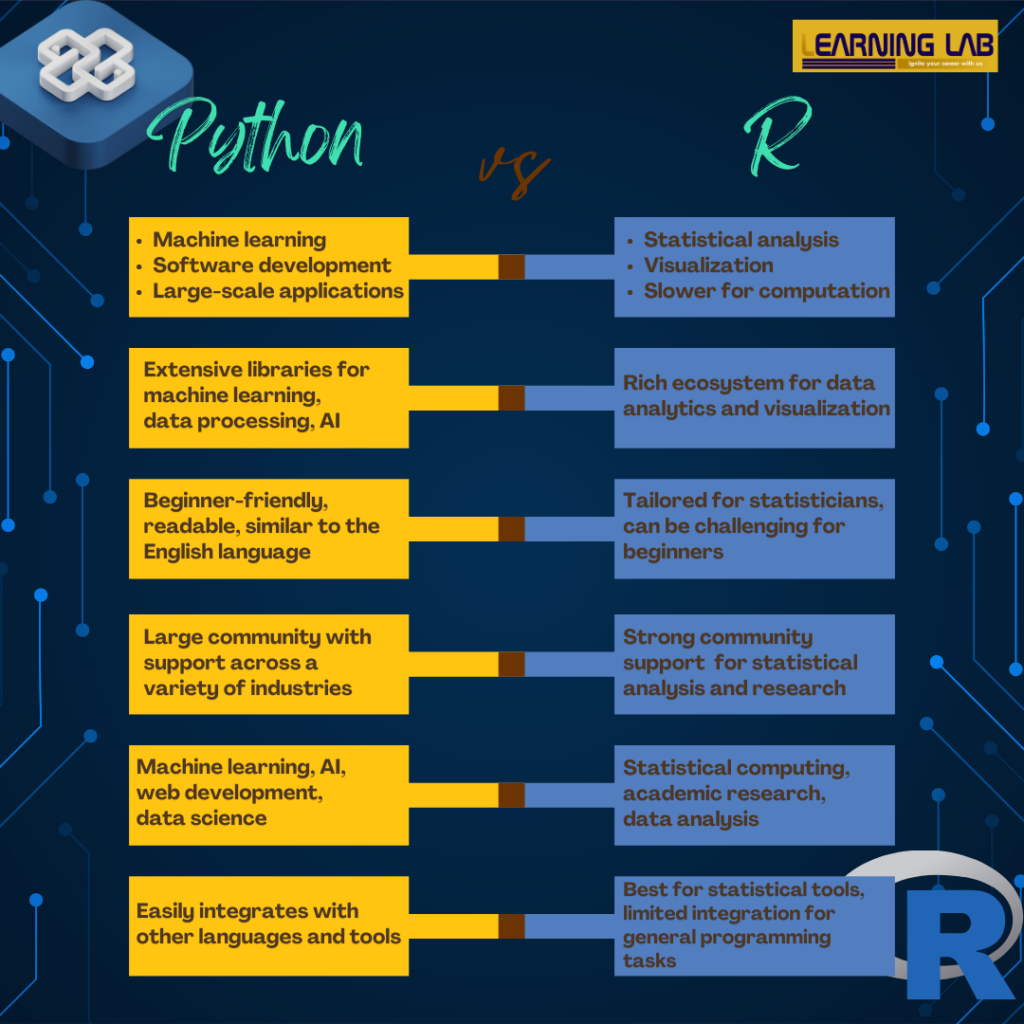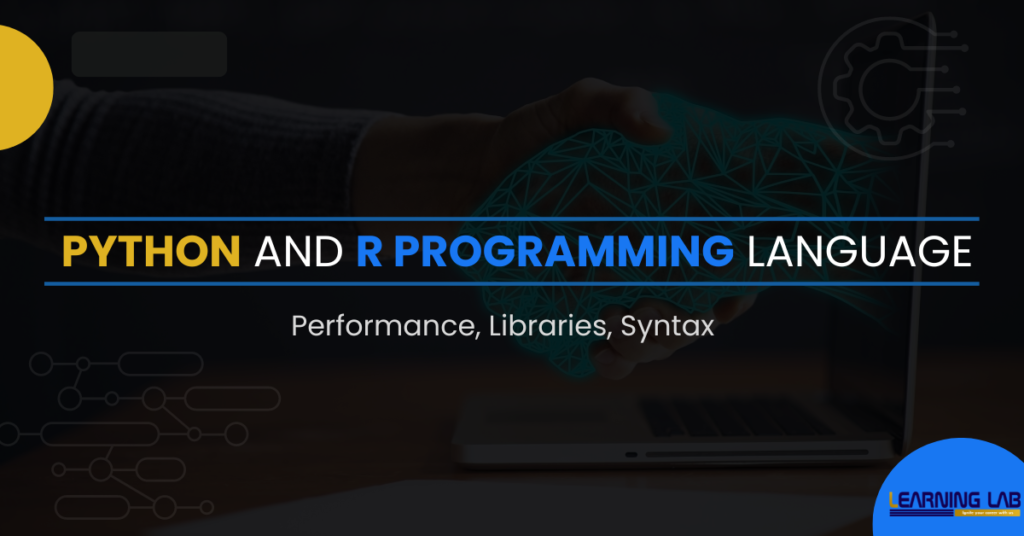Python vs R: When it comes to data science, machine learning, and statistical computing, Python and R are two of the most popular programming languages. Both offer powerful features and have large communities, but the difference between Python and R programming language make one more suitable than the other depending on the use case.
In this blog, we will explore the difference between Python and R programming languages in terms of performance, libraries, and syntax. Read on…
Difference Between Python and R Programming Language
Both Python and R are widely used in data science and analytics. However, each has its own unique strengths. While Python is known for its simplicity and versatility, R is primarily used for statistical analysis and visualization.
Now, let’s look at the difference between Python and R programming languages based on key aspects such as performance, libraries, and syntax, shall we?

Python vs R Performance
Python Performance
Python is a general-purpose programming language that excels in versatility. It has better performance when it comes to handling large-scale applications, software development, and machine learning algorithms. Python’s ability to integrate with different tools and languages, like C++ and Java, makes it faster for computation-heavy tasks.
R Performance
On the other hand, R is specifically designed for statistical computing and has excellent performance when handling data analysis tasks, especially with large datasets. However, when it comes to heavy computational tasks and real-time data handling, R may not really match Python’s speed.
In terms of “Python vs R performance”, Python tends to be faster for complex machine learning tasks, while R shines when performing statistical analysis.
Python vs R Libraries
Python Libraries
Python offers a wide range of libraries, especially in fields like machine learning, artificial intelligence, and data processing. Libraries such as NumPy, Pandas, TensorFlow, and Scikit-learn are extensively used for deep learning, data manipulation, and machine learning tasks. This makes Python a preferred choice for machine learning engineers and developers.
R Libraries
R’s strength lies in its rich ecosystem of packages for statistical analysis and data visualization. Libraries like ggplot2, dplyr, and caret are among the most commonly used in data analysis. R also has extensive packages for bioinformatics, econometrics, and epidemiology.
However, in the “Python vs R libraries” debate, Python offers a more versatile collection, while R is more focused on data analytics.

Python vs R Syntax
Python Syntax
Python is known for its easy-to-read, clean, and beginner-friendly syntax. Its code is written in a way that closely resembles the English language, making it intuitive for people who are new to programming. Python’s syntax encourages writing concise and readable code, which is why it is a go-to language for developers and data scientists alike.
R Syntax
R’s syntax, on the other hand, can be more challenging for beginners. It was built with statisticians in mind, and its syntax is tailored to statistical computing. Therefore, someone with a background in statistics may find R more comfortable.
However, R’s syntax is less readable compared to Python, which is one of the reasons why Python has gained more popularity among non-statisticians.
In terms of “Python vs R syntax”, Python is more accessible for beginners, while R offers more advanced statistical functionalities but with a steeper learning curve.
Now, onto the most important part of this blog….
When To Use Python vs R?
- Choose Python: If your project involves machine learning, artificial intelligence, or software development. Python is also ideal for projects that require the use of multiple tools and integration with other languages.
- Choose R: If you are a statistician or data scientist working on data analysis, visualization, and statistical computing, R will provide you with the tools and libraries specifically built for such tasks.
Python vs R Libraries: Which One Has the Edge?
Who doesn’t love some edge, right? Both Python and R have strong library ecosystems, but they cater to different needs. For those focusing on AI, machine learning, and data science applications, Python libraries like Pandas and TensorFlow are invaluable. On the other hand, R’s libraries are unparalleled when it comes to statistical analysis and data visualization.
Python vs R Syntax: What About the Ease of Use?
Another key difference between Python and R programming language is in their syntax. Python is often easier for beginners to pick up due to its readability and simplicity. In contrast, R has a more complex syntax that may challenge newcomers but rewards users with powerful statistical functions.
Python vs R Performance: Which Is Better?
When we talk about Python vs R performance, Python is generally more versatile and faster for most tasks except when it comes to heavy statistical computation, where R might be the better option. Python’s integration with big data platforms and machine learning tools makes it an all-rounder, while R remains unbeatable in niche statistical operations.

On A Final Note…
Python is generally preferred for its versatility and simplicity, making it suitable for a wide range of applications. On the other hand, R excels in statistical analysis and visualization, making it the go-to choice for specialized data tasks.
By focusing on Python vs R performance, Python vs R libraries, and Python vs R syntax, you can better assess which language aligns with your project requirements. At the end of the day, whether you choose Python or R, both languages offer robust tools and capabilities for data analysis and visualization.
What is the difference between Python and R syntax?
Python syntax is beginner-friendly and intuitive, with a focus on readability, making it easy for new programmers to pick up. R, on the other hand, has a more specialized syntax for statistical analysis, which can be more challenging to learn for beginners.
What is the difference between Python library and R package?
Python libraries are extensive and are used across a wide range of domains, including data science, web development, and AI. R packages, however, are specifically designed for statistical analysis and visualization, providing tools tailored for statisticians and data scientists.
What is the difference between Python and R functional programming?
Both Python and R support functional programming, but R was specifically built with functions in mind, often providing more powerful and flexible tools for statistical computations. Python, while supporting functional programming, tends to be more versatile across different paradigms of programming.





